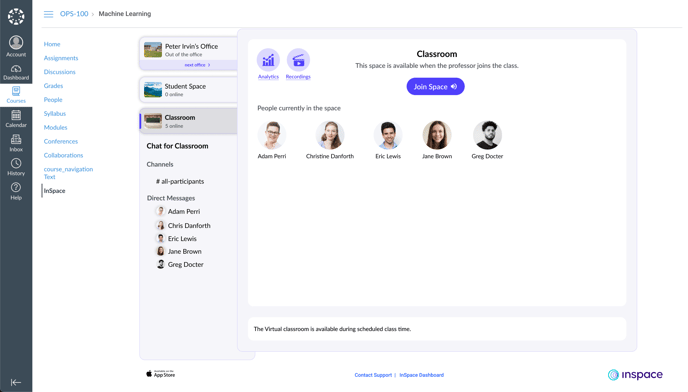Learn how to set up and activate InSpace LTI 1.3 for Canvas in your institution using our comprehensive guide. Get started today!

Note: These general instructions can be followed by institutions wanting to install InSpace who have also received access to the InSpace admin dashboard. Please contact your InSpace customer success manager if you have any questions about your access.
Step 1: Configure InSpace LTI 1.3 for Canvas
1.1 Navigate to Developer Keys in your root account in Canvas.
1.2 Click on the "+ Developer Key" button.
1.3 Choose "+ LTI Key" option.
1.4 Fill the "Key Name" field with "InSpace Key".
1.5 Select "Enter URL" as "Method".
1.6 In the "JSON URL" field paste the following URL:
- https://api.inspace.chat/lti-13/config-default-enabled.json if the InSpace integration should be enabled by default for all courses. If you select this option, InSpace will automatically appear in the Course Navigation Menu.
-
https://api.inspace.chat/lti-13/config-default-disabled.json if the InSpace integration shouldn't be enabled by default for all courses. If you select this option, instructors will need to go to Settings > Navigation, and drag InSpace into the visible area, then save their settings for the Course Navigation Menu.
1.7 Click "Save".
1.8 Set state to ON for the "InSpace Key" developer key.
1.9 Copy the number from the Details column. This is your “Client ID”.
Step 2: Install the LTI at the Root Level, into Sub-Accounts or Specific Course(s)
2.1 Navigate to account, a sub-account or course [specific course] settings.
2.2 Select the Apps tab, then click View App Configurations.
2.3 Click on “+Add”
2.4 Select “By Client ID” as Configuration Type.
2.5 Paste in the Client ID you copied in step 9 above into the Client ID field.
2.6 Click "Submit."
2.7 Click "Install."
2.8 Click on the gear icon, select Deployment ID. Save this number to share with InSpace in Step 4.
Step 3: Configure the API key for Canvas (optional)
To create InSpace channels based on Canvas sections: To have automatically created InSpace channels based on Canvas sections, here are some additional steps that should be done:
3.1 Navigate to Developer Keys in your root account in Canvas.
3.2 Click on the “+ Developer Key” button.
3.3 Choose the “+ API Key” option.
3.4 Fill the “Key Name” field with “InSpace Canvas Key."
3.5 Fill the “Redirect URIs” field with https://api.inspace.chat/lms/canvas/oauth2response
3.6 Move “Enforce Scopes” switch to “ON” state.
3.7 Check “Allow Include Parameters.”
3.8 In the “Permissions” list scroll to “Sections”, expand it, and check “url:GET|/api/v1/courses/:course_id/sections”
3.9 Click “Save.”
3.10 Set state to ON for the “InSpace Key” developer key.
3.11 Copy the number from the Details column. This is your “API Client ID.”
3.12 Click on the “Show Key” button from the “Details” column, and copy the value in the popup, this is your “API Client Secret."
Step 4: Share your integration information with your InSpace customer success manager.
4.1 To complete the integration, contact your InSpace customer success manager and share the following information with them.
- The URL(s) used for your institution's Canvas instance, including any Canvas vanity URLs or redirects.
- The Client ID you created in step 1.9.
- The Deployment ID you created in step 2.8.
- The API Client ID and API Client Secret from steps 3.11 and 3.12.
Other Situations:
- If you'd like to test InSpace's LTI with a Test or Beta instance of Canvas, you will need to request that your Instructure account representative enable "Beta and Test Access for Students". This resolves a bug in how Canvas’s Test/Beta instance handles the Names and Roles feature in LTI 1.3. You can request that your Instructure account rep disable this feature after you complete your testing.
